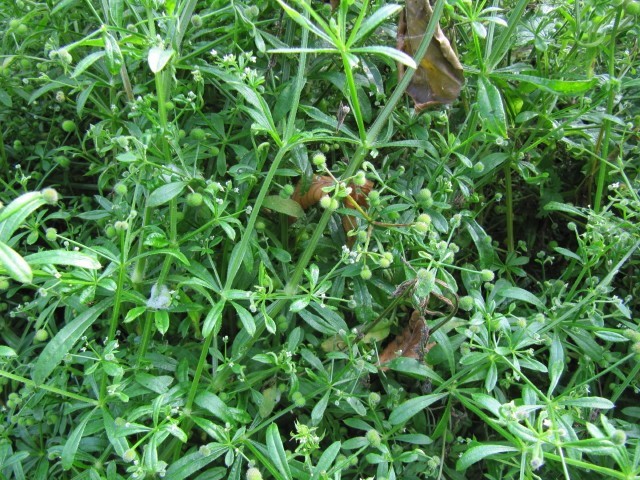|
Goose Grass Gallium aparine Lady's Bedstraw Galium verum Cleavers (Gallium aparine)Qualities of Goose Grass
An abundant straggling plant clambering through the undergrowth and climbing through the hedgerows. Its seeds cling to animal fur to aid distribution. Its luxuriant keen growth in spring brings a cleansing, moving refreshing energy of determination and direction. The family it belongs to are known as the bedstraws for their lush green foliage traditionally provided bedding ( see Lady's bedstraw). The bedstraws have four-angled stems and their leaves are arranged in whorls. Common Name: Cleavers Latin : Galium aparine Family: Rubiaceae History and/or use: Good spring tonic and nutritious vegetable boiled or eaten raw when very young. Wildlife Value: Food plant for insects. Goose Grass or Cleavers is a common plant that can be eaten as a green vegetable. Its seeds can be roasted to make a hot beverage. Medicinally the plant is an astringent and diuretic. It is used to help heal inward and outward wounds as well as being used to cleanse them. Internally it is used to treat psoriasis and eczema and support the lymphatic system. The plant is best used fresh as it loses its medicinal qualities in the drying process. Please note the plant can be a skin irritant. If you have any medical conditions please check with a medical herbalist first before taking any plant and only harvest it if you are 100% sure what it is! The plant clings or cleaves to fur/materials to aid its distribution, giving it the name of cleavers. Shepherds have used it to strain hair out of sheep’s milk, and it has been fed to goslings, giving rise to the name Goose Grass. There are many related species including hedge, heath and lady’s bedstraw which are all part of the bedstraw family ( Rubiaceae) so called as they are plants traditionally used for bedding. Medicinally many species of bedstraw are used for staunching wounds especially woodruff, hedge, heath and lady’s bedstraw. The last two species are known for being styptics and therefore are good for treating nosebleeds. Lady’s bedstraw (Galium verum) is so named because the Virgin Mary is said to have given birth to Jesus upon it as all the other fodder was eaten by the donkeys. This story may be rooted in the folk tradition that the plant is said to help women to have a safe and easy childbirth. Lady’s bedstraw is also known to treat urinary diseases, epilepsy and gout and to help tired feet when placed in the bath. Its yellow flowers were used to curdle milk given rise to the folk names of ‘cheese rennet’ and ‘cheese running’. Both the leaves and stem of this plant create a yellow dye and the roots create a red dye. Crosswort ( Cruciata laevipes) is another bedstraw especially reputed for healing wounds. It grows in open woodlands and has yellow-green hairy leaves and numerous tiny yellow flowers. I usually dry the whole plant, steep it in oil for at least two weeks on a sunny windowsill, drain and add beeswax to produce an ointment. If you would like to support our work and go even more deeply into Nature Connection please become a member and have exclusive access to our online course.
1 Comment
3/25/2020 06:04:33 pm
I admit that I am not really an expert when it comes to plants. But I am so much willing to learn since it is vacation and I have time for reading. This is the very first time I’ve seen Cleavers. Looking at it, I noticed that there is a special feature that all of us should notice. I guess, I should allot more time for observation because if I will do that, I will be able to see more details that I haven’t seen before. That sounds pretty exciting, isn’t it?
Reply
Leave a Reply. |
Details
Poetry of flowersJoin me to explore the flora of the British Isles on this blog. My intention is to attempt to capture the unique quality and beauty of each species of flower, tree or shrub. For every species featured I will be growing many more wildflowers to celebrate the joy of their existence, their intrinsic conservation value and bewildering array of uses. For nearly 30 years I have noted, studied and explored wildflowers in the field much to the patience of the walker beside me. To share this passion is a heartfelt plea to respect, preserve and care for all British Wildflowers no matter how common they seem. Archives
February 2024
Categories |



 RSS Feed
RSS Feed
